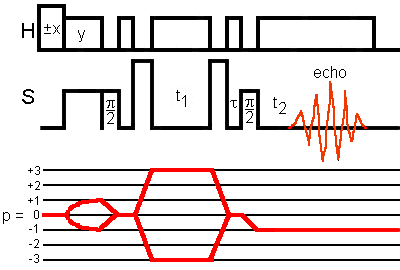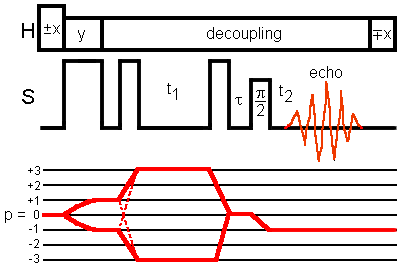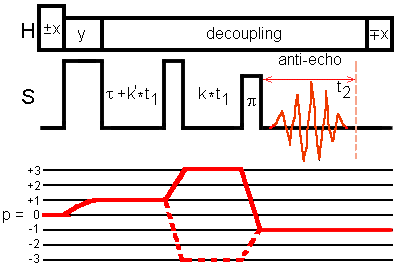1Q Cross Polarisation MQ-MAS
Pruski and coworkers and Fernandez and coworkers introduced the cross-polarization process into the MQMAS experiment, allowing editing of the high-resolution spectra of half-integer quadrupole nuclei.

This sequence employs 1Q CP to create a spin-locked 1Q S-spin central transition coherence.
A soft pi/2 pulse is then used to orient the newly created S-magnetization along the z-direction.
The (amplitude-modulated) z-filter sequence is used to generate the -1Q coherence.
The sensitivity of this approach, due to the number of coherence transfer steps involved, could be poor.
Triple-quantum coherences are mostly created from a population difference across the central transition, a process which is expected to be inefficient unless high RF field is applied.
Amplitude-modulated experiment should generate pure absorption 2D lineshape.
ACQUISITION: Hyper-complex or TPPI
Shearing transformation is required to obtain 2D isotropic (in F1 dimension) anisotropic (in the F2 dimension) correlation spectrum.
Ashbrook and Wimperis proposed two methods where the single-quantum coherences created by cross-polarization are transferred directly into MQ coherences in a manner analogue to the two-pulse excitation of MQ coherences used in solution NMR.
First method

This figure represents the (amplitude-modulated) z-filter experiment where p = ±3 coherences are excited from the p = ±1 coherences created by the cross-polarization.
The 'flip-back' pulse aids the recovery of the proton equilibrium magnetization.
Amplitude-modulated experiment should generate pure absorption 2D lineshape.
ACQUISITION: Hyper-complex or TPPI
Shearing transformation is required to obtain 2D isotropic (in F1 dimension) anisotropic (in the F2 dimension) correlation spectrum.
Second method

This figure represents the phase-modulated 'reversed split-t1' 3QMAS experiment for spin I = 3/2 (solid coherence transfer pathway) and S = 5/2, 7/2, or 9/2 (dotted coherence transfer pathway).
The split-t1 period is reversed, that is, the single-quantum comes before the multiple-quantum evolution period.
The triple-quantum coherence is excited from the single-quantum coherence created by the cross-polarization.
The 'flip-back' pulse aids the recovery of the proton equilibrium magnetization.
Pure absorption 2D lineshapes are ensured by the acquisition of the whole echo.
ACQUISITION: F1-QF
Shearing transformation is avoided.
